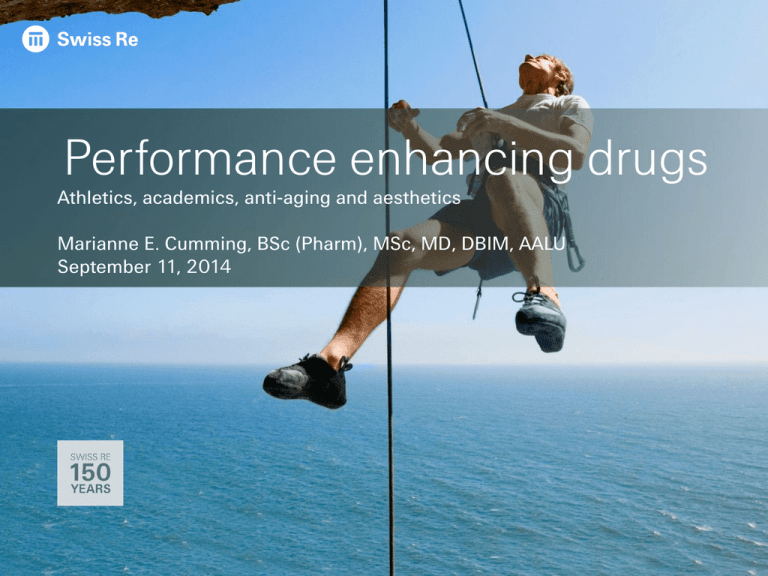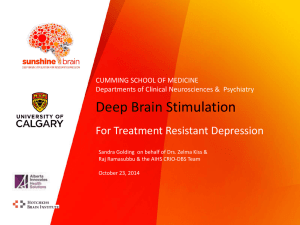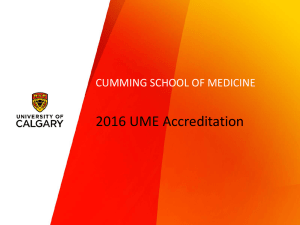
Performance enhancing drugs
Athletics, academics, anti-aging and aesthetics
Marianne E. Cumming, BSc (Pharm), MSc, MD, DBIM, AALU
September 11, 2014
Table of Contents / Agenda
• Performance enhancement: definitions
• User characteristics
• Enhancer characteristics
• Neuro-enhancers
• Anabolic-androgenic steroids
• Other enhancers
• Underwriting considerations
Dr. Marianne Cumming | MUC | September 11, 2014
2
Performance enhancement:
definitions
Dr. Marianne Cumming | MUC | September 11, 2014
3
Performance enhancement
• Performance:
– action or process of carrying out or accomplishing an action, task, or function
• Enhance:
– intensify, increase, or further improve the quality, value, or extent of
• Performance-enhancing drug:
– "any substance taken to perform better athletically"
– most commonly associated with elite competitive sports…
Dr. Marianne Cumming | MUC | September 11, 2014
4
Performance enhancement: medical models
The foundation of modern pharmacy is medical innovation and drug
development within a disease-based model.
Several factors contribute to the increased use of drugs as enhancers
Medicalization common conditions
formerly not considered "disease"
Use of pharmaceuticals in absence
of disease or medical condition
disease awareness campaigns,
direct-to-consumer advertising
physical enhancement, cognitive
enhancement or both
self-directed medical care,
"lifestyle drugs"
with or without athleticism
accessible health information via
internet
with or without "performance"
increasing "off-label" prescription
drug use
("without the work")
Dr. Marianne Cumming | MUC | September 11, 2014
5
Enhancer benefits: perceptions or deceptions
"Transhumanism":
transform human condition by developing & making
available technologies to greatly enhance human
intellectual, physical, psychological capabilities
• increase energy, reduce fatigue
• increase endurance
• increase strength
• improve physical performance
Improve and
maintain
function
• improve physical appearance
• increase muscle mass
• decrease body fat
• improve concentration
Competitive
advantage
Health and
wellness
promotion
• improve cognitive performance
• financial gain
• perceived safety and efficacy
• and so much more..
The wealth of promotional information and the dearth of evidence-based recommendations
related to benefits and risks serve to translate wishful thinking into widespread and not
always sensible use of 'enhancers'
Dr. Marianne Cumming | MUC | September 11, 2014
6
Enhancers: the insurance applicant
• Increasing acceptance and use in the general population
• Increasing identification in insured groups
– motivated, successful, competitive
– well-educated, well-informed
– health conscious, perceived benefits
– peer pressure
– potential financial and career incentives
– expanded "indications" for enhancer use, the four A's
– athletics
– academics
– anti-aging
– appearance
Dr. Marianne Cumming | MUC | September 11, 2014
7
Medical enhancing drug: definition
Any substance taken to feel or look better
The list is long; select examples:
Athletics
•Anabolic steroids
•Testosterone
precursors
•Human growth
hormone (HGH)
•Human chorionic
gonadotropin
•Erythropoietin
•Creatine
•Stimulants
•Opioids
Academics
Anti-aging
•Stimulants
•Amphetamines
•Caffeine
•Methylphenidate
•Modafinil
•Armodafinil
•Beta-blockers
•Athletics list
•Academics list
•Aromatase
inhibitors
•Metformin
•Other hormones –
thyroid, melatonin
•Others - statins
Appearance
•HGH
•Androgens
•Mesotherapy
Dr. Marianne Cumming | MUC | September 11, 2014
8
38 year old male, professional athlete, life insurance
applicant
• Highly publicized use of performance-enhancing drugs
• Reported substances include AAS and HGH, dosages unavailable
Dr. Marianne Cumming | MUC | September 11, 2014
9
28 year old female, PhD student, life insurance applicant
• No diagnosed medical condition
• Takes methylphenidate during preparation for examinations
• Prescribed by her regular physician, no evaluation
Dr. Marianne Cumming | MUC | September 11, 2014
10
58 year old male, successful entrepreneur, life insurance
applicant
• Fit, healthy, active, no medical conditions although recent diagnosis "adult
growth hormone deficiency"
• Rx: testosterone, somatotropin (Norditropin), DHEA, finasteride (Propecia),
Marine Fish oil, Men's multivitamin
• Prior omega-3, lycopene, coenzyme Q10, melatonin, indole-3-carbinol,
glucosamine chondroitin, methylsulfonylmethane (DMSO, MSM)
Dr. Marianne Cumming | MUC | September 11, 2014
11
Performance enhancement:
user characteristics
Dr. Marianne Cumming | MUC | September 11, 2014
12
The performer
Athletic
likely younger, generally healthy, recreational and professional sports
supra-physiologic dosages, poly-pharmacy, legal and/or illegal sources, variable monitoring,
possible non-disclosure
co-existing psychiatric diagnosis or substance (alcohol, tobacco, opioids, other) misuse, risk-taking
behaviors (accidents, violence, illegal activity), sport-related risk
Academic
all ages, likely younger and healthy, possibly higher education level
variable monitoring, legitimate manufacture, poly-pharmacy less likely, possible non-disclosure
co-existing psychiatric or substance misuse
Aesthetic
all ages; likely older, possibly higher socio-economic, education level
poly-pharmacy, legal sources, good access to care and monitoring, disclosure Rx more likely
co-existing medical (or psychiatric) conditions
Dr. Marianne Cumming | MUC | September 11, 2014
13
Athletics: long history of enhancer use
Enhancers:
highly
prevalent
throughout
the history
of modern
sport with
no end in
sight
early 1900s - Strychnine, caffeine, cocaine, alcohol
1928 – International track and field association, first doping ban
1960 - Olympic cyclist amphetamine-related death prompted drug testing
1966 - Cycling and football/soccer (FIFA) first drug testing
1967 - International Olympic Committee first list prohibited substances
1972 – First full scale drug testing program; stimulants, opioids
1976 - Anabolic steroids added to the list, reliable detection method developed
1999 – World Anti-doping Agency (WADA), independent, international agency ,
unified standards and coordinated efforts, list >100 banned substances
2000 – United States Anti-doping Agency (USADA), Olympic, Paralympic, Pan
American , Parapan American sport
Dr. Marianne Cumming | MUC | September 11, 2014
14
Risk profile: male college athletes using performance
enhancers
• 234 college male athletes
– PED users (n=73) in past
year (stimulants, hormone
precursors, supplements)
more likely to report
problem alcohol and drug
use compared to nonusers
(n=160)
– Buckman et al, J Stud Alc
Drugs 2009
Dr. Marianne Cumming | MUC | September 11, 2014
15
Professional athletes:
compared to insured groups
• Pro athletes
– ages 20-40, 1970-2000
– baseball, basketball, football, hockey
– violent deaths more common
– most were motor vehicle accidents
– medical deaths less common
– few "high profile" athletes
– more deaths in off-season
– overall, no significant difference in
athlete mortality vs other insured
young males
– Pinkham, Contingencies 2001
Dr. Marianne Cumming | MUC | September 11, 2014
16
Performance enhancement:
enhancer characteristics
Dr. Marianne Cumming | MUC | September 11, 2014
17
Enhancer risk: drug or supplement itself
Enhancer types, names, dosages
•multiple -vs. single - enhancers common
•intentional or inadvertent nondisclosure possible
•dosage may vary from therapeutic recommendations
•route of administration: potentially unsafe practices
•legal vs. illegal enhancer
•FDA regulation as drug or supplement – or not at all
Prescriber details
•attending physician(s), or alternate prescriber/supplier
•legitimate or illegitimate prescriber
•may or may not be available in APS
Source
•attending physician: adequate follow-up, identification adverse effects more likely
•trainer, internet or other sales: adequate follow-up less likely
•enhancer: legitimate Rx with proper manufacture and quality controls, with FDA regulation; vs. other
sources less reliable manufacture, potential contaminants, possibly less rigorous regulation as
dietary supplement
Dr. Marianne Cumming | MUC | September 11, 2014
18
Neuro-enhancers
Dr. Marianne Cumming | MUC | September 11, 2014
19
The universal enhancer:
caffeine - health benefits and risks
Potential benefits
• increased mental alertness, energy,
ability to concentrate
• enhanced athletic performance
• analgesia
• possible decreased risk: type 2
diabetes, Parkinson's, Alzheimer's,
liver cirrhosis, myocardial infarction
(low dose)
• possible decreased risk: liver,
endometrial cancer, (breast cancer
uncertain)
• possible decreased all-cause
mortality risk
•Nehlig 2010, Lopez-Garcia et al, 2008
Potential risks
• short-term: headache, anxiety,
tremors, insomnia
• long-term: anxiety (GAD, panic
disorder), depression, antisocial
behavior, substance misuse
• cardiac: coronary or arrhythmic
events, acute BP elevation
• increased fracture risk, lower BMD
• increased risk lung and bladder
cancer (confounded by smoking)
• withdrawal: headache, fatigue,
nausea, irritability, depression;
>100mg/d, peak 1-2d, duration<9
days
World Anti-Doping Agency (WADA): 2004, caffeine removed from banned
list, previous limit >12mcg/mL (8C coffee) until research demonstrated
this amount more likely detrimental to performance
Dr. Marianne Cumming | MUC | September 11, 2014
20
Cognitive enhancers (CEs)
Smart drugs,
nootropics
Cognition- or
neuroenhancers
Academic
doping
Cosmetic
neurology
Psychostimulants
"Brain gain"
Dr. Marianne Cumming | MUC | September 11, 2014
21
Smart drugs: stimulants: amphetamines, methylphenidate,
and more
• Medical and non-medical uses for
100+ years
– athletic competition
– military - enhanced alertness
• Stimulants: amphetamine,
methylphenidate, modafanil
– Increasing prevalence in normal
healthy individuals: 5% to 35%
– depression
– Improved cognitive abilities: most
consistent in clinical populations
– attention-deficit hyperactivity
disorder (ADHD)
– Mixed results in healthy individuals:
• More recently
– extensive off-label use in healthy
individuals:
– increased alertness, energy or
concentration
– some studies - enhancement with
improved memory and executive
functioning
– others - report impairment or
detrimental effects
– Smith and Farah, 2011
– academic and business settings
Dr. Marianne Cumming | MUC | September 11, 2014
22
Cognitive enhancers
Stimulants
• caffeine
• cocaine
• amphetamine, dextroamphetamine
(Adderal, Dexedrine)
• methylphenidate
(Ritalin, Concerta)
• modafinil (Provigil)
• armodafinil (Nuvigil)
• lisdexamfetamine
(Vyvanse )
• dimethylphenidate
Focalin
• ephedrine (2004 ban)
Cognitive benefits
• improvement in:
• learning
• executive function
• working memory
• attention
• concentration
• energy
• speed
• endurance
• motivation
Adverse effects
• insomnia,
nervousness,
anorexia, psychosis
(rare
• tachycardia,
hypertension,
ischemic or
hemorrhagic stroke,
arrhythmias,
myocardial infarction
• vocal and motor tics,
tremors, seizures,
hyperthermia
• addiction potential
Dr. Marianne Cumming | MUC | September 11, 2014
23
Modafinil
• Approved: excessive daytime
sleepiness associated with
narcolepsy, sleep apnea
• Non-medical use in military and
increasing use in academic,
business settings
• Studies demonstrate cognitive
benefits in healthy individuals
• May be better tolerated than
amphetamines
– Repantis et al 2010, Müller et al
2013
Dr. Marianne Cumming | MUC | September 11, 2014
24
Anabolic-androgenic steroids
Dr. Marianne Cumming | MUC | September 11, 2014
25
Anabolic-androgenic steroids
• US Anti-Doping Agency (USADA),
2009, 26/8000 tests positive
• US surveys, androgens:
– 1% population uses androgens
– 80% users recreational athletes or
body builders
– adolescent users: 3.6% high school
students, mostly boys
– more common
• Survey: 500 anabolic-androgenic
steroid users:
– 78% - non-competitive body builders
or non-athletes
– 60% - >1000 mg testosterone or
equivalent per week
– 99% - self injected
– 25% - also used growth hormone
– 95% - polypharmacy
– cycling, baseball, weightlifting
– 100% - reported adverse effects
– with personal or family history of
drug misuse
– Parkinson AB, Evans NA, 2006
Dr. Marianne Cumming | MUC | September 11, 2014
26
Anabolic-androgenic steroids and other hormones
• Testosterone, and its derivatives:
– increase muscle mass and strength
• Anabolic steroids
– synthetic derivatives of testosterone
• Testosterone precursors
– androstenediol, androstenedione and dehydroepiandrosterone (DHEA)
• Human chorionic gonadotropin (hCG)
– stimulates testosterone production
• Tetrahydrogestrinone (THG)
– potent androgen "designer steroid", developed to escape urine testing detection
Dr. Marianne Cumming | MUC | September 11, 2014
27
Anabolic-androgenic steroids
Testosterone and derivatives
Adverse effects
•Injectable androgens
•testosterone enanthate (Delatestryl),
cyprionate (Depo-testosterone),
nandrolone
•Oral androgens
•danazol, fluoxymesterone,
methandrostenolone,
methyltestosterone, oxandrolone,
oxymetholone, stanozol, testolactone
•Transdermal testosterone
•Gels - Androgel, Fortesta, Testim
•Patches –Androderm, Andropatch,
(Testoderm)
•Spray - Axiron
•Buccal testosterone – Striant
•Pellets – Testopel implants
•liver – abnormal LFTs, hepatitis,
tumors (17-alpha alkylated)
•abnormal lipids, erythrocytosis
•decreased glucose tolerance
•increased CV disease
•infections - septic arthritis, hepatitis,
HIV
•males - testicular atrophy, oligospermia, gynecomastia; females –
irreversible virilization
•males – prostate cancer
•adolescents – premature growth
cessation, epiphyseal closure
•Psychiatric – emotional lability, mania,
depression, aggression
•Tendon rupture
Dr. Marianne Cumming | MUC | September 11, 2014
28
BMJ, January 10, 2014
2002: 0.8% US men
Rx testosterone,
$324million
"Low T" campaign
non-injectable: gel,
patch, buccal,
underarm roll-on!
2012: 3m Rx,
$3billion (10-fold
increase annual sales)
ADAM 'screening test'
- Androgen Deficiency
in Aging Males
direct-to consumer
advertising, samples,
disease awareness
campaigns
Dr. Marianne Cumming | MUC | September 11, 2014
29
The fifth "A"? Andropause? or the epidemic of
testosterone deficiency
• Testosterone in males
– primarily produced in testes, regulates libido, helps regulate bone mass, fat
distribution, muscle mass, strength, erythrocyte and sperm production
– serum levels decrease with age – and with obesity, diabetes mellitus, pituitary
disease or trauma, acute illness, nutritional deficiency, certain drugs (opioids,
glucocorticoids, other steroids, GnRH analogs)
– some studies demonstrate benefit in aging males (sex drive, muscle mass, wellbeing) but long-term risks unclear
– high doses may cause erythrocytosis, increased risk testosterone-dependent
diseases (prostate cancer, BPH), serum cholesterol and CV risk (mixed reports)
– FDA approved for hypogonadism, not as anti-aging therapy
Dr. Marianne Cumming | MUC | September 11, 2014
30
Dr. Marianne Cumming | MUC | September 11, 2014
Testosterone therapy and cardiovascular risk
Observational retrospective veterans
cohort
•Vigen et al, JAMA 2013
•8709 males, mean 63 yrs, T
<300ng/dL, 27.5 months follow-up,
•748 deaths, 443 MI, 519 strokes
•Co-morbidities - DM 50%, CAD
80%, prior MI 20%, obese 50%
•1223 Rx T: patch (63%), injectable
(36%), gel (1%); initial T 175
increased to 332 mg/dL
•T use associated with increased risk
all-cause mortality, MI, & ischemic
stroke (HR,1.29; 95%CI,1.05-1.58;
P = .02)
•Unchanged after adjusting for CAD
(HR,1.29; 95% CI, 1.04-1.58)
Other studies with increased
cardiovascular risk
Systematic review , meta-analysis
placebo controlled RCTs
•Basaria et al. NEJM 2010
•209 males, mean 74y, limited
mobility, co-morbid hypertension
(80%), DM (25%), dyslipidemia
(60%), obesity (45%), current (9%),
former smokers (65%),
•Increased risk CV events 23 (v.
placebo, 5); T group improved
leg/chest press, stair climb
•Finkle et al, PLoS One 2014
•Retrospective insurance claims,
•55,593 males, mean 54y, comorbid hypertension (27%) antidiabetic Rx (15%), dyslipidemia
(26%), heart disease (10%)
•Men >65 2X risk MI in first 90
days after initial Rx; <65 with hx
HD 2-3X risk MI 90 days no excess
risk in men without hx HD
•Corona et al. Expert Opin Drug Saf
2014:
•75 studies, n=3016 T therapy
(2448 placebo), mean age 60y,
duration 34 weeks.
•Analysis no causal role between T
and adverse CV events; improved
metabolic profile, increased LBM,
decreased fat with T use
•Xu et al BMC Medicine 2013:
•27 studies, n= 2,994, middle aged
& mainly older, men; 180 CV events
•T therapy increased risk CV related
event (OR 1.54, 95%CI 1.09-2.18)
•Risk CV events higher in studies
without pharmaceutical industry
funding (OR 2.06, 95%CI 1.34-3.17) vs
those with (OR 0.89, 95%CI 0.50-1.60)
Dr. Marianne Cumming | MUC | September 11, 2014
32
Testosterone therapy: cardiovascular risk?
Vigen et al, JAMA 2013: retrospective observational study: 8709 males, VA, mean 63 years, T
<300ng/dL, 27.5 months follow-up, 748 deaths, 443 MI, 519 strokes. T use associated with
increased risk all-cause mortality, MI, & ischemic stroke (HR,1.29; 95%CI,1.05-1.58; P = .02)
Unchanged after adjusting for CAD (HR,1.29; 95% CI, 1.04-1.58)
Finkle et al PLoS One 2014: retrospective insurance claims data, 55,593 men, increased risk MI
with testosterone therapy
Corona et al. Expert Opin Drug Saf 2014: systematic review and meta-analysis placebo controlled
RCTs on T and CV risk. 75 studies, 3016 testosterone therapy and 2448 placebo patients, mean
duration 34 weeks. analysis did not support causal role between testosterone and adverse
cardiovascular events. rather supported T to improve metabolic profile, increased lean body mass
and fat reduction.
Dr. Marianne Cumming | MUC | September 11, 2014
33
Androgen precursors:
• Androstenedione, "andro"
– bodybuilders, promoted as nutritional supplement until classified as Rx in 2004
– may or may not increase testosterone levels and no evidence that it increases
muscle strength
• Dehydroepiandrosterone (DHEA)
– dietary supplement (not FDA regulated), promoted to increase muscle strength
– although converted to testosterone, studies show DHEA but not testosterone
levels increased
– mixed results, small study - no differences in lean body mass comparing "andro",
DHEA, placebo; another study - increased strength in males with DHEA
• Adverse effects
– potential for liver damage, estrogen and testosterone dependent cancers,
cardiovascular disease
Dr. Marianne Cumming | MUC | September 11, 2014
34
Other enhancers
Dr. Marianne Cumming | MUC | September 11, 2014
35
Aromatase inhibitors increase testosterone levels in males
Anastrozole (AZ): aromatase inhibitor, offlabel use for male hypogonadism, increases
T levels by lowering serum estradiol (E2),
increasing gonadotropin (GTP) levels
38 males, 65 treatments, mean age 60,
BMI 32, hypogonadism, tx testosterone
pellets (TP), with or without AZ, baseline
hormone levels similar
After 120 days tx, total T, free T and average
change in T levels higher (E2 lower and GTP
higher) in TP AZ group vs. TP alone
Men on TP AZ maintained therapeutic T
levels longer than men on TP alone
Mechlin et al, J Sex Med 2014
Dr. Marianne Cumming | MUC | September 11, 2014
36
Cosmetic mesotherapy
• Injection of substances locally into subcutaneous tissue
– "microscopic quantities of homeopathic medications, traditional pharmaceuticals,
vitamins, minerals, amino acids into the skin to treat a variety of conditions"
– local fat reduction, skin rejuvenation, hair restoration, (back pain)
• Two forms of mesotherapy for local fat reduction
– Lipolytic: activation of lipolysis in fat cells - aminophylline, isoproterenol,
yohimbine (additive)
– Ablative: fat cell destruction using a detergent - phosphatidylcholine, deoxycholate
• Complications, case reports
– infection (most frequent, atypical mycobacterium), skin reactions, acute psychosis,
ischemic colitis, thyrotoxicosis, nephropathy
– Jayasinghe , Bissoon et al, Obes Rev. 2013
Dr. Marianne Cumming | MUC | September 11, 2014
37
Human growth hormone (HGH) (somatropin): athletics,
anti-aging, appearance
• Decline in serum GH with age is observed yet clinical consequences are
unknown, "replacement" is not recommended, and off-label use in USA is
not approved
• Potential benefits
– increase in lean body mass (more muscle) decrease in fat mass
– sprint capacity increased, no effect on strength, power or endurance
• Adverse effects
– glucose intolerance, diabetes, edema, hypertension, arthralgias, myopathy
– possible association with substance misuse, other PEDs (AAS), opioids, cocaine
• $$$$
• US Brand Names: Genotropin, Humatrope, Norditropin, Nutropin,
Omnitrope, Saizen, Serostim, Tev-Tropin, Zorbtive
Dr. Marianne Cumming | MUC | September 11, 2014
38
Creatine: athletics
• Popular nutritional supplement:
– increase strength, improve high-intensity performance, such as weight lifting
(heavy resistance training)
– not banned BUT supplements containing creatine may be contaminated with
banned drugs
• Sources:
– endogenous production liver, kidney, pancreas; also dietary meat and fish
• Open, 21-month study in college football players, average 5 grams/day, no
detectable adverse effects (Kreider et al, Mol Cell Biochem 2003)
• Adverse effects, case reports:
– edema, weight gain, muscle cramps, acute interstitial nephritis (?later chronic
renal disease) (Persky & Brazeau, Pharmacol Rev 2001)
Dr. Marianne Cumming | MUC | September 11, 2014
39
Dietary supplements: proceed with caution
Dr. Marianne Cumming | MUC | September 11, 2014
40
Dr. Marianne Cumming | MUC | September 11, 2014
41
Performance enhancement:
underwriting considerations
Dr. Marianne Cumming | MUC | September 11, 2014
42
58 year old male, successful entrepreneur, life insurance
applicant
• testosterone cyprionate injection – previous 50 mg 2x/weekly, increased to
140 mg weekly (200 mg/ml inject 0.35 ml twice weekly)
• growth hormone (Norditropin) 0.25 mg/d, increased to 0.3mg/d
Dr. Marianne Cumming | MUC | September 11, 2014
43
Enhancers: underwriting considerations
Likely favorable
• full disclosure on application
• single Rx, FDA approved for a
condition, regular dosage
• legitimate prescription and
manufacture
• regular monitoring by a physician
• no co-existing medical conditions
• no or well controlled
cardiovascular risk factors
• no psychiatric impairments
• no alcohol or substance misuse
Less favorable
• inadequate information
• multiple Rx, high dosage, and/or
dietary supplements
• no prescription and questionable
source of medication
• no monitoring, physician unaware
• co-existing medical conditions
• presence of cardiovascular risk
factors
• psychiatric history
• alcohol or substance misuse
Additional factors: age, enhancer properties, reason for
use, therapeutic substitute, sport-related risk
Dr. Marianne Cumming | MUC | September 11, 2014
44
Enhancers: underwriting information
• underwriting source of drug information, i.e. admitted or from third party
• indication(s) for drug use
• current drug(s) and/or dietary supplements, dosage, duration of use
• prescriber details
• drug source details
• any complications resulting from current or previous PED use
• liver and renal function test results
• any co-existing medical or psychiatric conditions
• any current or history of alcohol or substance misuse or use disorder
• drug questionnaire
Dr. Marianne Cumming | MUC | September 11, 2014
45
Dr. Marianne Cumming | MUC | September 11, 2014
46
Legal notice
©2014 Swiss Re. All rights reserved. You are not permitted to create any modifications
or derivative works of this presentation or to use it for commercial or other public purposes
without the prior written permission of Swiss Re.
The information and opinions contained in the presentation are provided as at the date of
the presentation and are subject to change without notice. Although the information used
was taken from reliable sources, Swiss Re does not accept any responsibility for the accuracy
or comprehensiveness of the details given. All liability for the accuracy and completeness
thereof or for any damage or loss resulting from the use of the information contained in this
presentation is expressly excluded. Under no circumstances shall Swiss Re or its Group
companies be liable for any financial or consequential loss relating to this presentation.
Dr. Marianne Cumming | MUC | September 11, 2014
47







